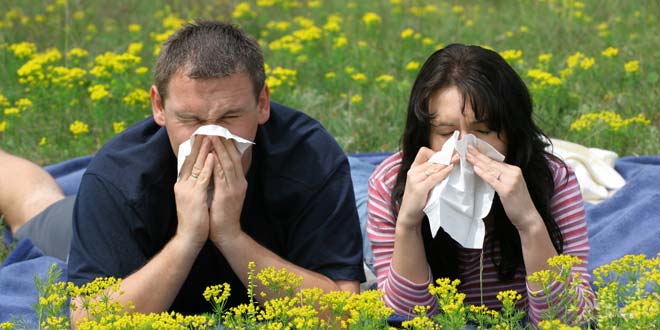While some allergy symptoms can be similar to those of a common cold, they are quite easily distinguishable. Allergies last as long as you are exposed to the allergen and tend to occur at regular intervals. A common cold has more pronounced symptoms, lasts three to 14 days, and does not occur at regular intervals.
Comparison chart
| | Allergy | Common Cold |
|---|---|---|
| Symptoms | Cough, fatigue, sore throat, runny or stuffy nose, itchy and watery eyes, sneezing, stuffy nose | Cough, aches, fatigue, sore throat, runny or stuffy nose, sneezing, stuffy nose, sometimes skin reaction. |
| Fatigue | Sometimes | Sometimes |
| Aches | No | Sometimes |
| Fever | Never | Sometimes |
| Indication | Immune system's response to allergens. | Viral infection of the upper respiratory tract. |
| Sore throat | Rarely (with mold) | Often |
| Treatment | Antihistamines, Decongestants, Nasal steroids, Allergy shots. | Antihistamines, Decongestants, nonsteroidal anti-inflammatories, extra rest, drink plenty of fluids. |
| Sneezing | Usually | Usually |
| Cause | Allergens (dustmites, pollen, food, mold, etc.) | Rhinovirus |
| Stuffy nose | Usually | Usually |
| Time of Year | Any time of the year -- some allergens are seasonal (spring) | Most often in the winter, but possible at any time |
| Onset of symptoms | Symptoms can begin immediately after exposure to the allergen. | Symptoms take a few days to appear after infection with the virus. |
| Cough | Seldom (only with mold) | Often |
| Itchy, watery eyes | Often | No |
| Runny nose | Often; usually clear mucus | Often; usually yellow viscous mucus |
| Prevention | Avoid allergens | Prevent cold-causing virus from getting into system: keep distance from people with colds, wash hands |
Cause
Allergic reactions are the immune system's response to certain allergens, which could be anything from food to things in the environment, like dust mites, mold, pollen, animal hair, etc.
The common cold is a viral infectious disease of the upper respiratory tract and primarily affects the nose. There are over 200 virus strains implicated in the cause of the common cold, but the most common cause is the rhinovirus.
Symptoms
Common symptoms of allergies include itchy and watery eyes, a runny nose with clear mucus, sneezing and a stuffy nose. Less common symptoms include a cough, sore throat and fatigue. Symptoms can begin immediately after exposure to the allergen.
Common symptoms of colds include a cough, sore throat, sneezing, a runny nose with yellow mucus and a stuffy nose. Less common symptoms include aches, fatigue, and an occasional fever. Symptoms take a few days to appear after infection with the virus.
Time of the Year
Although both an allergy or the common cold can catch you unawares at any time, they occur at different times of the year, and have a different duration.
Allergies can occur at any time of the year, but the appearance of most common allergens like pollen is seasonal, usually during the spring. Allergies last from a few days to months, but only as long as the person is exposed to the allergen.
The common cold most often occurs in cold weather, and typically lasts from three to 14 days.
This video highlights the typical differences between an allergy and the common cold:
Prevention
Preventing allergies generally only means avoiding the allergens. Common allergens include pollen, mold, animal dander, dust mites and cockroaches.
Preventing a cold involves preventing the cold-causing virus from getting into the system, by keeping a distance from people with colds and washing hands frequently.
Treatment
Allergies are treated with antihistamines. Antihistamines block histamine, which is a substance that causes the symptoms of allergies. Decongestants, which reduce the swelling in nasal mucus membranes, are another effective treatment. For more severe allergies, nasal steroids may be necessary to reduce swelling in the nasal passage. Some allergy sufferers require allergy shots, which mean getting injected with small amounts of the allergen in order to become tolerant to it. Over-the-counter antihistamines like Allegra and Claritin are the most common.
Antihistamines and decongestants are also used to treat the common cold. Additionally, taking non-steroidal anti-inflammatory drugs like Advil or Tylenol help relieve aches and pains. Many over-the-counter cold medicines combine antihistamines, decongestants and nonsteroidal anti-inflammatories. Resting more and drinking a lot of fluids are also typical treatments for the common cold.


 Common Cold
Common Cold  Allergy
Allergy  Sore Throat
Sore Throat  Allegra
Allegra  Claritin
Claritin  Advil
Advil
Comments: Allergy vs Common Cold